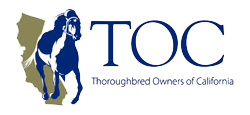How Lead Changes Can Affect Performance
By Tracy Gantz
“He didn’t change leads.”
Just another jockey excuse? Not necessarily. If your horse failed to change leads in the stretch, that loss of acceleration could cost him the win. Changing leads comes naturally to horses. When negotiating a turn at a gallop, they will use their inside lead. In other words, turning left-as in a race-a horse’s feet will hit the ground in a four-beat cadence: right hind, left hind, right front, left front. Thus, as you watch him, his left front foot is “leading” him around the turn.
The correct lead is “the easiest method to get the shortest distance between two points in the quickest way,” said Dr. Ray Baran, the racing association veterinarian at Southern California tracks. By being on the inside-or correct-lead, a horse is in balance, Dr. Baran explained. He pointed out that all performance horses benefit from correct leads, something especially notable in polo ponies. “They are entirely dependent on leads because they have to turn and go after that ball fast.”
At U.S. racetracks, Thoroughbreds must use their left lead on the turns. “That’s the real purpose of changing leads for horses,” said Hall of Fame jockey Chris McCarron. “They’re able to negotiate a turn to the right or to the left more adeptly when they’re on the proper lead.”
But running an entire race on the left lead will tire a horse more quickly than if he switches leads. So when a horse receives his first lessons, before he gets to the racetrack, he learns to switch to his right lead in the straight-aways. When he does it correctly, a horse can surge past his rivals, especially if the competition doesn’t change leads.
“When they switch to the right lead, it gives them a burst of energy,” said trainer John Sadler. “It’s very important.”
Many people concentrate on whether a horse changes leads in the stretch driving to the finish line, but changing to the right lead down the backside can help a horse as well.
“It’s especially important for horses that have the propensity to stay on their left leads in the lane,” McCarron said. “If you don’t get them to change down the backside, they’re already going to start to get tired before they even change up at the head of the lane. Then if they don’t change, now you’re adding fatigue on top of fatigue and they’re going to hang and stop.”
McCarron recalled the Triple Crown battles between Affirmed and Alydar in 1978. “I can’t help but think that if Alydar had changed leads in any one of those races, he might have had a little better chance of getting by Affirmed,” said McCarron, who won the 1987 Kentucky Derby and Preakness aboard Alydar’s son Alysheba.
Not every horse needs a lead change to win, however. Arazi burst into prominence by winning the 1991 Breeders’ Cup Juvenile and never switched leads in the stretch. Point Given in this year’s Preakness switched leads close to the wire, but had already put away the rest of the field.
McCarron rides a talented filly for trainer Ron McAnally, Janis Whitman’s Beautiful Noise, who also doesn’t always need to switch leads. “She’s done something that in 27 years of riding I never had a horse be able to do,” McCarron said. “Twice she has run 71/2 furlongs on her left lead and won. She’s very, very stubborn about changing leads. She’s done it her whole life.” The jockey has learned not to push the filly to change leads. “I can interrupt her momentum by fighting with her,” he said.
Normally, though, trainers and jockeys try to convince a reluctant animal to switch. Sadler said he has improved horses by getting them to switch leads. He added that it’s important to have a good exercise rider who can help teach the horse in the morning, “and then you’ve got to have the jockeys working with you in the afternoons.”
Both Sadler and McCarron said that the keys to a successful lead change are the bridle and the rider’s weight, not the whip.
When McCarron needs to ask a horse for a lead change, he first takes a stout hold of the horse’s head. He uses the reins to steer the horse a little to the right, then back to the left, and then a more abrupt signal to the right. “You might see the head move,” he said, “but I don’t necessarily want the horse’s body to float out and go into the path of somebody else. My duty, my responsibility is to make sure I keep the horse straight.”
Those signals with the reins put tension on the bit, which will usually get a horse to switch to his right lead. If that doesn’t work, “then I involve my weight,” McCarron said. “I’ll lean one way or the other in the same sequence-a little bit right, a little bit left, and then-boom-back to the right again. Angel Cordero taught me that one a long time ago.”
While some horses are just reluctant to change leads, it can sometimes indicate a soundness problem. Dr. Baran said if a horse that previously showed no difficulty changing leads suddenly won’t change, “it might mean he’s comfortable in that lead and he’s hurting in that other leg somewhere. You’d better investigate it.”
Sadler watches lead changes when he looks at 2-year-olds in the training sales. “This year I saw a horse sell at Barretts,” he said. “The first preview, he went down the stretch in his left lead. The second preview he went down the stretch in the left lead. I still liked the horse. We vetted him, and he had a ton of problems.” The horse ultimately started for someone else at Hollywood Park. Sure enough, he ran down the stretch on his left lead and finished out of the money.
Sadler also pays attention to sale prospects that change leads too often because “usually it’s a sign of sore shins,” he said.
“I had one really good horse that didn’t switch leads a lot-Olympic Prospect,” Sadler said. “I think it was because he had problems and he felt more comfortable in his left lead. Also, he was so big that it was kind of an effort for him to switch. So he won a lot of races on the left lead. They can do it, but it’s rare.”
Sadler has also ridden jumpers, who must leap obstacles quickly and turn both to the left and to the right. “You’re going for time, so you’re turning in the air,” he said. “If you want to turn left, you need him to land on his left lead.” Lead changes are such a sign of an athletic horse that they are often part of Olympic dressage competition. And Dr. Baran cited the importance of lead changes when a horse cuts cattle.
“Sometimes you look at a particularly gifted horse, and they’ll switch leads just so smoothly,” said Sadler. “Those are the really special ones.”






